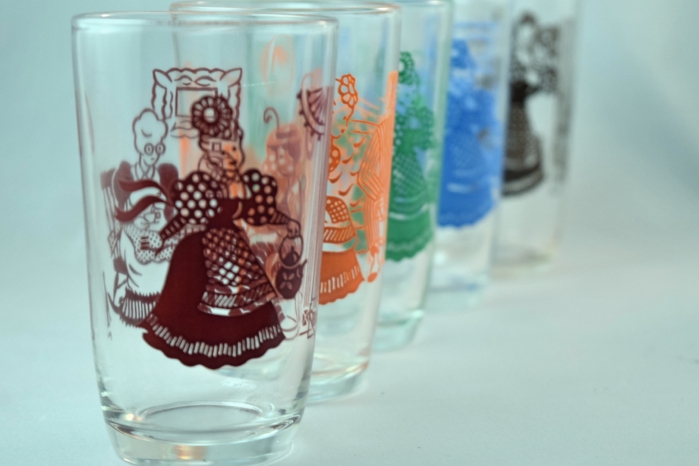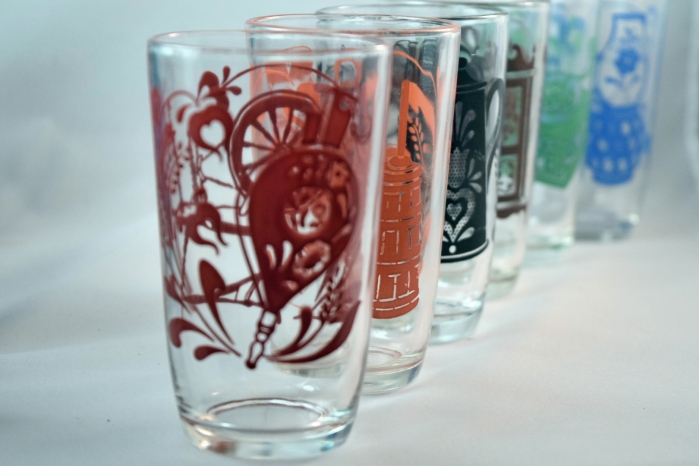The history of Swanky Swigs began during the first part of the 20th century when James Kraft developed processed cheese spread. Most Americans have heard the term Swanky Swigs and typically apply it to all vintage, decorated tumblers. Through experience with vintage glassware collectors and thorough research I have learned that Swanky Swigs was the title used by Kraft to describe the re-usable glass containers that held Kraft processed cheese spread during the 1930s. Search “swanky swig” in Google and thousands of results pop up but none are dictionary definitions. However, search for each term separately and the results are:
- swanky: stylishly luxurious and expensive
- swig: drink in large gulps
Hmmm…
History
When the stock market fell in 1929 and the Depression Era was in full swing, Kraft Foods began an all new marketing plan to sell their cheese spread in re-usable glasses. Swanky Swigs debuted in grocery stores in 1933, a time when “waste not, want not” was more meaningful than ever. Kraft realized American housewives would be drawn to a product offered in a premium/glass re-usable jar. This launched a new marketing strategy for Kraft directed at the typical housewife of the time. The goal: market non-essential, luxury items in a fashion consistent with the national pervading thought that every penny must be used wisely and to make consumers feel guilt free about their purchase. It was simple yet effective. Empty glass cheese spread jars could be washed out and put to new use as decorated beverage tumblers.
Kraft partnered with the Hazel Atlas Glass Co. to manufacture hand painted glass containers for distribution of Kraft processed cheese spread. Kraft offered the containers as premiums until the late 1950s when coincidentally the plastic era boomed (☆read post on plastics☆). Hazel Atlas manufactured the majority of glass jar containers on the market.
Swanky swigs were available in the United States, Canada, and Australia and contained a large variety of Kraft processed food items. Kraft used the phrase “collect them all” in many ads to encourage continued consumer shopping and brand loyalty.

Colors
The silk screen process used by Hazel Atlas after the initial hand painted pattern application used during the first year of production did not afford a large variation in pattern color. Standard colors for all swanky swigs were: red, orange, yellow, green, blue, black, and brown. This is reminiscent of the color rainbow acronym taught in grade school ROYGBIV. I will take an educated guess that as such the standard colors were probably the most simple to create.

Available Sizes
In America, there are 3 standard sizes available:
- 3.50″
- 3.75″
- 4.25″
Swanky?
Perhaps the ability to use adorable, often hand painted glass tumblers during the depression was seen as swanky/luxorious. The first pattern, Band 1933, was painted by hand and all future patterns were applied using a silkscreen process. Maybe households that could afford to purchase the products offered in the premiums were better off and had more access to money than other, less fortunate individuals that scraped by with the bare essentials like milk and bread. I can see why one might see the little glass jars that would hold just a few ounces of fluid as a swanky swig: processed cheese spread was not and is not a necessity thereby viewed as swanky and the small volume of the glasses could be easily downed in one gulp or swig.
document.getElementById(‘ShopifyEmbedScript’) || document.write(”);
Buy Vintage Swanky Swigs-Kraft "Kiddie Kup Pattern" Baby Animal Swankyswig 1956
Important Things to Remember
- NEVER put swanky swigs or any vintage glassware in the dishwasher ♡ color WILL fade and peel
- Know your swanky swig info!! Dealers often lump all vintage decorated tumblers under the umbrella term swanky swig ♡ TRUE swanky swigs contained Kraft Foods product
- RetroReclaimations.com Swanky Swigs Offer
- We offer a nice assortment of Swanky Swigs in the Vintage Glassware Swanky Swig Collection. All can be viewed for curiosity, pleasure, or purchase by clicking this collection.
Do you collect Swanky Swigs? If so, I would enjoy hearing about it! Share your collection story and images via email and use subject line Swanky Swig.
References:
Florence, Gene and Cathy. “The Hazel Atlas Glass Identification and Value Guide”. Collectors Books, 2005.
History.com Staff. “The Great Depression”. History.com. A+E Networks, 2009. Accessed 20 June 2016. http://www.history.com/topics/great-depression
Mink, Michael. “James Kraft Cooked Up New Cheese and A New Market”. Investors Business Daily News. 2014. Accessed 18 June 2016. http://www.investors.com/news/management/leaders-and-success/james-kraft-founded-kraft-cheese/
“swanky.” American Heritage® Dictionary of the English Language, Fifth Edition. Houghton Mifflin Harcourt Publishing Company, 2011. 22 June 2016 http://www.thefreedictionary.com/swanky
“Swig.” American Heritage® Dictionary of the English Language, Fifth Edition. Houghton Mifflin Harcourt Publishing Company, 2011. 22 June 2016 http://www.thefreedictionary.com/swig
“waste not, want not.” McGraw-Hill Dictionary of American Idioms and Phrasal Verbs. The McGraw-Hill Companies, Inc., 2002. 22 June 2016 http://idioms.thefreedictionary.com/waste+not%2c+want+not